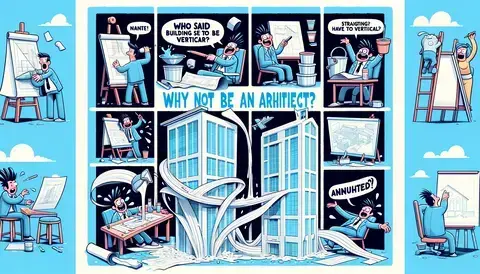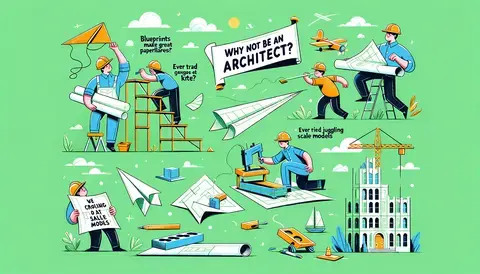Why Not be an Architect?
2024 Guide: Why Not be an Architect? 8 Reasons Why You Should NOT Become an Architect

Choosing a career in architecture is a significant commitment and, like any profession, it may not be the right fit for everyone. Here are some reasons why someone might decide not to pursue a career as an architect:
Long Education and Licensure Process: Becoming a licensed architect requires several years of education, followed by completing internships and passing licensure exams. This lengthy and often expensive process can be daunting.
High Levels of Stress and Responsibility: Architects often work on tight deadlines and deal with high-stakes projects. They bear significant responsibility for the safety and functionality of their designs, which can be stressful.
Economic Fluctuations Impact Job Security: The demand for architects can vary with the economy. During times of economic downturn, construction projects may decrease, impacting job stability in the architecture field.
Work-Life Balance Challenges: Architecture can be a demanding profession, with long hours and the need for flexibility to meet project deadlines, which can impact personal time and work-life balance.
Competitive Field: Architecture is a competitive industry, where reputation and portfolio quality can significantly impact one's ability to secure projects or employment.
Technological Advancements and Outsourcing: Rapid advancements in technology and the potential for outsourcing some architectural services can create additional pressures and competition in the field.
Subjective Success Measures: Success in architecture can often be subjective, depending on clients' or critics' tastes and perceptions, which can be challenging and unpredictable.
Environmental Impact Concerns: Some may be concerned about the environmental impact of construction and may seek professions that focus more directly on sustainability.
While architecture can be a rewarding career for many, offering opportunities for creativity, problem-solving, and tangible contributions to communities, it's essential for individuals to consider their interests, values, and lifestyle preferences when choosing a career path.
Questions and Answers
FAQs: Understanding the Challenges of Being an Architect

This is a detailed FAQ section, where we get into the complexities and challenges of the architecture profession. Whether you're an aspiring architect, a student, or just curious about the field, this section aims to provide clear and insightful answers to common questions about the difficulties and realities of a career in architecture.
What are the disadvantages of being an architect?
Long Hours and Intense Workload: Architects often face tight deadlines, leading to long hours and a high-stress work environment.
Economic Sensitivity: The demand for architectural services can fluctuate with the economy, affecting job stability and opportunities.
Responsibility and Liability: Architects are responsible for the safety and functionality of their designs, which can carry significant legal liabilities.
Competitive Industry: Standing out in the field requires exceptional skill, unique vision, and often a bit of luck, making it a highly competitive profession.
Cost of Education and Licensure: Becoming a licensed architect requires a substantial investment in education and training, which can be financially burdensome.
What is the hardest part of being an architect?
Achieving Design Intent: Ensuring the final constructed building aligns with the original design intent, despite various project changes and constraints, can be extremely challenging.
What problems do architecture students face?
Intensive Workload: The workload in architecture schools is notoriously intense, often requiring late nights and long studio hours.
Cost of Education: The expense of architecture education, including tuition and materials, can be a significant burden.
Theoretical vs. Practical Knowledge: Bridging the gap between academic theory and practical application can be difficult for students transitioning into the professional world.
What is the problem of being an architect?
Client Expectations vs. Reality: Balancing client desires with practical and regulatory constraints can be challenging and sometimes frustrating.
Keeping Up with Technology: Rapid advancements in design and construction technology require continual learning and adaptation, which can be demanding.
Work-Life Balance: The demanding nature of the profession can make it difficult to maintain a healthy work-life balance.
Why is it hard to be an architect?
Complexity of Design: Creating designs that are both aesthetically pleasing and functionally sound requires a deep understanding of many different fields.
Interdisciplinary Coordination: Architects must collaborate effectively with a range of professionals, from engineers to contractors, which can be complex and challenging.
Continuous Learning: Staying current with best practices, materials, technologies, and regulations requires ongoing education and adaptability.
What are the dangers of being an architect?
Physical Stress: Long hours, especially in front of a computer, can lead to physical strain.
Mental Pressure: The need to solve complex problems and meet client expectations can create significant stress and anxiety.
Professional Liability: Errors in design can have serious consequences, potentially leading to legal action.
Why is architecture so stressful?
High Expectations: The pressure to deliver innovative, functional, and aesthetically pleasing designs under tight deadlines contributes to stress.
Multifaceted Responsibility: Architects must consider numerous factors, including safety, sustainability, aesthetics, and client needs, which can be overwhelming.
What are the challenges for architecture in the future?
Sustainability: Designing energy-efficient, environmentally friendly buildings is increasingly crucial.
Urbanization: Accommodating growing urban populations in sustainable and humane ways presents complex design challenges.
Technological Integration: Incorporating new technologies, like AI and virtual reality, into the design process and built environment.
Do architects have a good future?
Evolving Opportunities: Despite challenges, the need for innovative and sustainable architectural solutions ensures continued demand for skilled architects.
Technological Advancements: New tools and methodologies offer exciting opportunities for the field.
Is an architect a good future career?
Rewarding Creativity: For those passionate about design, architecture offers a fulfilling outlet for creative expression and problem-solving.
Impact on Society: Architects significantly influence the built environment, contributing to the cultural and functional fabric of society.
Is there a future for architects?
Yes: The future holds opportunities, especially as the focus on sustainable and resilient design grows.
Diversification: Architects may find opportunities in related fields like urban planning, product design, or virtual environment design.
How challenging is architecture?
Intellectually Demanding: The field requires both creative talent and technical knowledge, making it intellectually stimulating but challenging.
Competitive: Standing out requires dedication, innovation, and continuous improvement.
How hard is an architecture degree?
Rigor: Architecture degrees are demanding, with a blend of creative design projects, technical coursework, and theoretical studies.
Time Commitment: The degree often involves long studio hours and significant project work.
Can architects work alone?
Freelancing: While possible, architects working independently face challenges like acquiring clients, managing all aspects of a project, and handling business operations.
Collaboration: Even independent architects usually collaborate with other professionals on larger projects.
Collaborative Nature of Architecture
Teamwork is Essential: Even when working solo, architects must often coordinate with engineers, contractors, and clients to ensure the successful realization of a project. The collaborative nature of architecture reflects the complexity and multidisciplinary demands of most building projects.
Challenges of Solo Practice
Business Acumen Required: Independent architects need not only design skills but also business management capabilities. They must handle marketing, finances, client relations, and project management, which can be particularly challenging without the support structure of a firm.
Resource Limitations: Solo practitioners may face limitations in terms of resources, such as access to high-end software, research materials, or the ability to take on large-scale projects without additional staff.
Professional Isolation: Working independently can lead to professional isolation, making it harder to stay informed about industry trends, new technologies, and regulatory changes without the built-in network of a larger firm.
The Future Landscape of Architecture
Interdisciplinary Opportunities: The future of architecture is increasingly interdisciplinary, merging with fields like environmental science, technology, and social research to create comprehensive solutions that address broader societal challenges.
Global Influence: Architects must increasingly consider global trends and influences, integrating international design innovations and adapting to the global market, especially in sustainability and disaster-resilient architecture.
Adaptability and Lifelong Learning: The rapid pace of change in both technology and society means that architects must continually learn and adapt, embracing new tools, materials, and concepts to stay relevant in the field.
What is the biggest problem in architecture?
Adapting to Climate Change: Creating sustainable and resilient designs that mitigate the impact of climate change is a significant and growing challenge.
Choosing to pursue architecture, whether within a firm or as an independent practitioner, offers a unique blend of creative expression, technical challenge, and societal impact. While the path can be demanding, it also provides the opportunity to shape the built environment and influence future generations. For those passionate about design and eager to tackle complex problems, architecture can be a deeply rewarding career.

